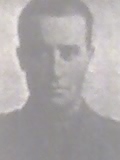

 The South African
The South African

Major P.N.G. Fitzpatrick
(Photo: South Africa Magazine, 1918).
Percy Nugent was born in Johannesburg in 1889, a mere four years after the gold-mining town, today a seething metropolis, had been founded. He was educated at one of South Africa's finest schools, St. Andrew's College, Grahamstown, where he excelled in sports of all kinds, and smashed all the school's swimming records. It was in 1910 that Nugent, in his twenty-first year, ventured abroad to attend Hertford College, at Oxford University, and it is not at all surprising, given his prowess at swimming, that Nugent Fitzpatrick obtained his swimming half-blue while at the University.
But war was drawing nigh, and upon commencement of hostilities, Fitzpatrick, who was at the time attending the Inns of Court, reading for the Bar, subsequently returned to South Africa with his parents. Nugent volunteered for military service in August 1914, and served with the Transvaal Light Horse (TLH), and the Imperial Light Horse Regiment (ILH). Nugent Fitzpatrick subsequently served with the Regiment, and the South African Forces, during the German South West African Campaign, the allied commander being the South African Statesman, General Louis Botha.
It was in September 1915 that Nugent Fitzpatrick again left for England, this time with the South African Heavy Artillery (SAHA). After training, Nugent embarked for France in April 1916, with a battery of 6-inch howitzers. Nugent was slightly wounded during the carnage that was the Somme. He spent a period of leave in South Africa in January, and again in June, 1917. Prior to his death, Nugent commanded the 71st siege battery of the South African Heavy Artillery (the SAHA being affiliated to the Royal Garrison Artillery of the British Army) for approximately eight to nine months. The battery saw action almost continuously for three months while in the Ypres salient, the legendary "Wipers". They then moved to Cambrai and experienced very heavy fighting, during the German counter attacks on Bourlon Wood.
Major Percy Nugent Fitzpatrick, together with a fellow Officer, Lieutenant Waller, were killed instantaneously, on the 14 December 1917, when they were struck by a "stray 4-inch shell while driving to railhead in the battery car." It is sad to think that Nugent was killed but a fortnight before his next period of leave. Major Percy Nugent George Fitzpatrick was said to have handled the battery magnificently, and that he "inspired confidence to quite an extraordinary degree, winning an enthusiastic devotion from his officers and men."(3)
At the time of his death, Major Fitzpatrick's parents were resident at Amanzi, Sir Percy Fitzpatrick's famous farm, nestled in the Sundays River Valley, in the Uitenhage District of the Eastern Cape. It was there that Sir Percy Fitzpatrick passed away, in January, 1931, while his dearly beloved son, the other Percy Fitzpatrick, lies buried in the Red Cross Corner Cemetry, at Beugny, a world far removed from the tranquillity of Amanzi(4). We will remember them.
1. 11 November
2. Affiliated to the Royal Garrison Artillery.
3. South Africa Magazine, January 19, 1918, p 85.
4. Commonwealth War Grave's Commission (CWGC): Grave/Memorial Reference, I.F. 13.
(c) Ross Dix-Peek 2007
Return to Society's Home page
South African Military History Society / scribe@samilitaryhistory.org